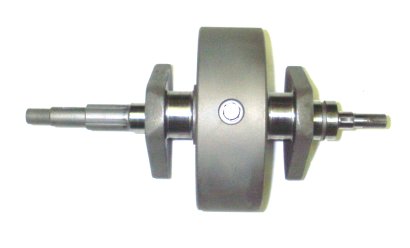Every time I go over to Mark's shop, I learn a little more, and this past month is no exception. I'd honestly say that this motor is a great thing to learn on, since it's simple, yet maintains principles that are continued with contemporary engines. I'm going to break it up, just like the motor parts, to try and keep records, and help explain what we're doing...
Bottom end: Being a unit twin, the cases house the transmission, the clutch and a bijillion other little things, but most importantly, it houses the crank, which looks like this:
On the left side, we've removed the old bearing, and I've purchased a NOS one with a new race. The crank itself is being ground down as we speak to fit the new -0.10 rod bearings (that's the smooth cylindrical part on either side of the big figgin' wheel in the middle). On the right, the "timing side" bearing was also replaced in a flurry of fire and ice (we froze the bearing and heated up the case to get it to fit) with a -0.10 and the crank is being ground here as well to match by Quinlin Automotive her in Indy. I'd love to say that this part was easy, but it wasn't. All-in (with amazing prices on the bearings) We're at $200 to rebuild the crank. However, it's a small price to pay to make the bike run smoothly for another 40 years.
Top end: I have to say that whenever you pull out a big acetylene torch to super-heat metal, it's nerve wracking. Here's the top end:
I polished the crap out of this, and it looked awesome, then we hit it with the torch to get the old valve guides out and got carbon all over it, so I've got to polish it again. Derp. The new guides went in pretty easily, but after lots of measuring, they need to be honed to 0.313 (7.95mm) for the new valves, which requires a new specialty reamer. We tested the springs, and they're all in good shape, so that's at least something I don't have to buy. So far, we're talking $175 to recondition and rebuild it. Ugh.
Pistons/Cylinder: My first thought was to take my cylinder, get new pistons at +0.40 over and bore it out. That would have cost $500. Shit. Now, my pistons are in great shape. They're Hepolite +0.20, and I have brand new rings for them.
Instead... I bought a used cylinder for $90 that I can bore out to +0.20 and not feel bad about. Genius. I can use my good race-quality pistons and rings, and get rid of a cylinder that already had a chip in the bottom. All I have to do is clean it up and repaint it with engine enamel and it's as good as new. (It's currently sitting in customs from Canada, because they might think it's a bomb.)



No comments:
Post a Comment